Isabella talks about the four crucial pieces of advice she’d give to any traveler about to do the Acatenango Volcano Hike, based on her own experiences of hiking Acatenango Volcano this year in January.
Climbing Acatenango Volcano is a rite of passage for just about anybody traveling through Guatemala. I had heard of it before we went to Guatemala and I knew I wanted to do it, but I didn’t realize quite how popular it would be; it was the talk of our hostel in Antigua.
Words of wisdom were passed down from one traveler to another like folklore tales as post-Acatenango and pre-Acatenango hordes gathered around the dinner table.
Now post-Acatenango myself, I can tell you the four most important pieces of advice we collected before adventuring 4,000 meters up a volcano:
- The first two hours of the hike are the hardest
- Take. The. Sticks.
- Ask for vegetarian food if you don’t have a strong stomach
- Acclimatize before you go
The First Two Hours of the Hike are The Hardest
A vibrant, curly-haired British girl said this to me on my first day in Antigua, and she might have saved the hike for us.
“Someone told me before I went that the first two hours are the hardest, and honestly if she hadn’t told me that then I might not have made it.”
I’ll talk more about acclimatization later, but the minivan that picks you up already takes you from 1,500m in Antigua to 2,400m at the trailhead. You have about twenty minutes to use the bathroom, hire some walking poles and take your last few comfortable breaths before the ascent begins.
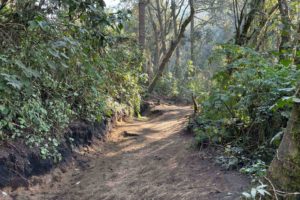 I was already exhausted, having been up all night thanks to the diuretic effect of the altitude sickness pills that didn’t even seem to do anything. I felt worse at this moment than I did trekking through the Salkantay Pass in Peru which is more than twice the altitude.
I was already exhausted, having been up all night thanks to the diuretic effect of the altitude sickness pills that didn’t even seem to do anything. I felt worse at this moment than I did trekking through the Salkantay Pass in Peru which is more than twice the altitude.
It must be the instantaneousness of it. A van whisks you up 900m in just over an hour and your body is like wait, you want me to climb further?
The Acatenango Volcano hike has regular stops along the way, with fifteen minutes of rest for every thirty to forty minutes hiked. That sounds like plenty, but at altitude, in the blistering sun, carrying heavy backpacks up a steep incline, the first thirty minutes were tough. It was also our first hike of the season, which didn’t help.
When we arrived at the first rest stop my friends and I eyed each other, pink in the face, sweating, and trying to find patches of shade from the sweltering heat. The look we shared was one of unease.
I clung onto the words of the curly-haired girl in the hostel, and sure enough after two hours of climbing and regular stops we headed into the shade and turned sideways onto the volcano, where the path was better kept, less slippery and much less steep.
Take. The. Sticks.
Another traveler I met in the very same hostel told me this, with an expression I can only describe as desperate. It was more of a plea than any kind of advice.
“Take. The. Sticks.” His tone was strong. “Whatever you do, take the sticks.”
And, of course, he was right.
When you arrive at the trailhead, there are a lot of people milling around. Selling snacks, collecting Quetzales to use the bathroom and renting walking poles.
We tried to rent proper walking poles, but for some reason to do with our tour company, we weren’t allowed. We were offered bamboo sticks instead (granted, they were much cheaper), which did the same thing but to slightly less effect.
In the beginning, the sticks didn’t seem to make much difference. It’s always nice to have a bit of weight off your legs, but it was nothing that would make me desperately plead to a stranger (and I am unapologetically the kind of person who would).
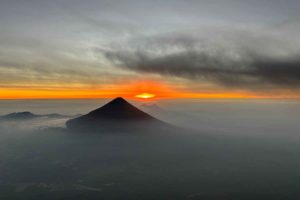 The sticks became more comforting the higher we climbed. As the air became thinner and we piled on the layers, my reliance on these third and fourth limbs grew.
The sticks became more comforting the higher we climbed. As the air became thinner and we piled on the layers, my reliance on these third and fourth limbs grew.
Just a few minutes before we reached base camp, we hit volcanic ash. If you’ve never waded through volcanic ash before, I have previously compared it to: walking up sand dunes, but harder; wading through a cat litter tray that’s five meters deep; being inside the mixing bowl right after you add powdered sugar.
At such a steep angle, it was almost impossible to climb with just your feet. The one or two people in our group who didn’t Take The Sticks were scrambling on their hands and knees. At the end of a hike with a 1,300-meter elevation gain, the entertaining side of things was not seen… and I have never been more grateful for a piece of bamboo.
The following morning we woke at 3.45 am to begin the summit hike. Unfortunately for just about everyone there, the entire trail was made up of volcanic ash. We only had a 300m elevation gain, but it took two hours to reach the top because every step required additional effort and advanced us about one-third of the distance it should have.
This was the toughest part of the climb, and it would have been entirely impossible without The Sticks.
Reaching the summit of Acatenango Volcano at precisely 3,976 meters was an insane feeling. I huddled together with the other members of our group who’d made it to the top (quite a few had stayed at base camp or turned around halfway to the summit) and watched the sun rise over the horizon. It was a sunrise I will never forget (and totally worth the lungfuls of volcanic ash I was still sneezing out three days later).
Ask For Vegetarian Food if You Don’t Have a Strong Stomach
This piece of wisdom came from a hostel on the shores of Lake Atitlan. I was vegetarian at the time, so I would have been saved from this horror either way, but this is a tale I repeat to everyone I meet who is planning to climb Acatenango.
We spoke to a Swiss woman in our dorm about the hike for quite some time (politely ignoring the fact that she had come home in the middle of the night with a huge bearded man that most definitely wasn’t a hostel guest).
On her hike up Acatenango, everyone apart from the vegetarians had gotten food poisoning. I didn’t fully understand how horrendous that must have been until I was there at base camp myself. The situation is pretty bleak: it’s bitterly cold, everyone is exhausted, and there are sixteen people to a hut, squashed up together like caterpillars in sleeping bags.
We were on the top level (the hut had two levels, like a giant bunk bed, with eight people on each), so there was a serious amount of shimmying and climbing to be done if you wanted to get in or out of bed. Then you have to wrestle your hiking boots back on, find a torch, and put on all your layers so you don’t freeze to death. Not ideal in an emergency situation.
There were thirty-two of us and one toilet.
Most of us actually took to doing nature wees because the toilet was soiled to the point of unusability (a sign that this poor Swiss woman’s tale was not of an isolated incident). After all, you pick up your lunch from somebody’s back door not long after sunrise and carry it in your pack under the sweltering heat for many hours before you eat it.
The dinner they served at base camp was just pasta with tomato sauce. Simple and, I like to think, difficult to poison people with.<
Acclimatise Before You Go
I have mentioned the altitude a few times throughout this article, but the elevation isn’t so much a problem as is the elevation. You go from 1,500 meters in Antigua to almost 4,000 meters at the summit in less than 24 hours. You sleep at around 3,700 meters.
For context, the recommendation is to climb no more than 500 meters per day over 2,500 meters.
As I mentioned, I’m no stranger to altitude: I have camped at almost 4,000 meters with minimal issues. I spent a long weekend partying in La Paz, the highest city in the world. I’ve been to Lake Titicaca, the highest navigable lake in the world. But, at Acatenango base camp, I swear to you that I could not breathe.
Gaining elevation that quickly is no joke, and we came across several people on the trail holding their feet over their heads. And this was all the altitude sickness medication.
After feeling such adverse effects at base camp, it was probably a bad decision to keep climbing to the summit, but I just can’t resist the temptation of a good sunrise. And, well, I’d never been on top of a literal volcano before. The best views came from base camp, where we could watch the neighboring Fuego Volcano erupt all night long, but the summit sunrise came in at close second.
Thanks to the volcanic ash situation we slip-slided back to base camp, with the help of our trusty sticks, of course. When I arrived at base camp, I wasn’t okay. I couldn’t catch my breath, I had a headache, and I was out of energy. The thought of descending all the way back down seemed like an impossible task. I sat on the dusty floor, slumped against the fence, as my best friend Ellie rushed about to bring me food, hot coffee and rehydration sachets. Thanks to her I perked up just enough to make it back down in one piece.
I will never regret watching that sunrise, but the next time I hiked at altitude you can bet I climbed much more slowly.

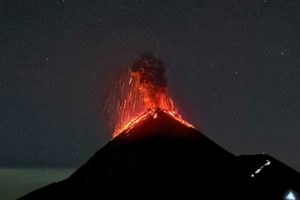
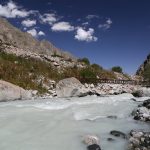
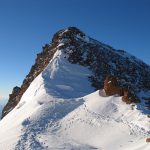
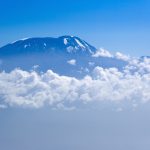

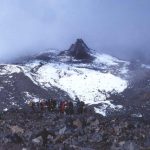

Leave a Reply